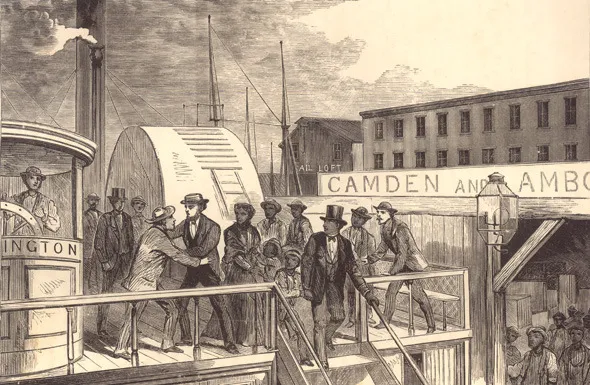Quaker Accounts of the Underground Railroad in the Region of Philadelphia Yearly Meeting
Compiled by Christopher Densmore, Curator, Friends Historical Library

See also the exhibit website, Quakers & Slavery
Considerations on the Underground Railroad
The following “considerations” are intended to place the study of the Underground Railroad into context.
- Opposition to Slavery took many forms; the main object was the elimination of slavery. The Underground Railroad, as it involved a relatively small number of individuals, was not the main object of the anti-slavery movement—the main object was the ending of slavery as a system.
- Those who worked on the Underground Railroad knew that it was the fugitives themselves who had taken the initiative and the major risks of escaping.
- The role of free and “self-emancipated” African American communities in aiding escaping enslaved persons, in protecting fugitives living in the North and in preventing the kidnapping and enslavement of free African-Americans has often been overlooked in writing about the Underground Railroad. More research is needed.
- The legal component of the Underground Railroad is important. Abolitionists and their allies used anti-kidnapping and “personal liberty laws” not only to prevent the enslavement of free people, but at times to hinder the recovery of fugitive slaves.
- Participation on the Underground Railroad by white citizens raised serious questions about the responsibilities of citizens to obey the laws balanced against the moral and religious responsibilities of individuals to follow their conscience and/or obey the will of God.
- The level of organization of the Underground Railroad varied over time and place. A relatively few “agents” and “station masters” were involved in well traveled routes, sometimes assisting, over the years, hundreds of fugitives. The involvement of other individuals may be limited to a single incident. Some, probably many, fugitives escaped with little or no help from the Underground Railroad.
- Anti-Slavery and Abolitionist activists were often deeply divided on means and ends. Both William Lloyd Garrison and Frederick Douglass were abolitionists, but they argued bitterly about the role of political action in the movement.
- Quakers, anti-slavery by long held belief and practice, were divided on the issue of joining with non-Quakers in reform organizations. Some, like Thomas Garrett and Lucretia Mott, worked actively with abolitionist organizations. Others, including active Underground Railroad agents like Samuel Moore of Bucks County and John Jackson of Darby, Delaware County, remained outside of the organized abolitionist movement.
- Secret rooms for hiding fugitive slaves, often a part of local legend, appear to have played little part in the Underground Railroad. The narratives of fugitive slaves and the account of Underground Railroad conductors describe hiding in cellars, attics, barns and fields, but secret compartments, if they existed at all, seem to be largely part of the twentieth century mythology of the Underground Railroad.
Documents and Readings
- Dr. Edwin Fussell: The Underground Railroad in Chester County, Pennsylvania.
- William T. Kelley: The Underground Railroad in the Eastern Shore of Maryland and Delaware.
- Edward S. Magill: The Underground Railroad in Bucks County, Pennsylvania.
- George S. Truman: The Sharon Female Academy, Delaware County, Pennsylvania.
- Chester County (Pennsylvania) Documents: Abolitionism, the Underground Railroad, Kidnapping and Quakers.



